Dartmouth Harbour
Dartmouth
boasts probably the most spectacular and beautiful
deep water harbour in the West Country, Dartmouth
is accessible at any state of tide, in any weather
and at any time of day or night. Situated within a
designated area of outstanding natural beauty. With
its breathtaking views it is not surprising Sir Francis
Drake regularly sailed here for pleasure, it is surely
a boat lover's dream come true. With warm summers
and mild winters, average sunshine hours being amongst
the highest in the country, you can see how the South
Devon coastline, with it's splendid sub tropical plants
and palm trees has been dubbed the 'English Riviera'.
Dartmouth
Town
Dartmouth town lies close
to the mouth of the River Dart and is one of the great
historic towns of England. It has been an important
trading port for centuries and sailors have set out
from here to sail the world.The Mayflower left here
for America in 1520, an event recorded on a stone.
Indeed, it was from the cobbled quay of Bayards Cove
in 1620 that the Pilgrim Fathers set sail for the
new world, 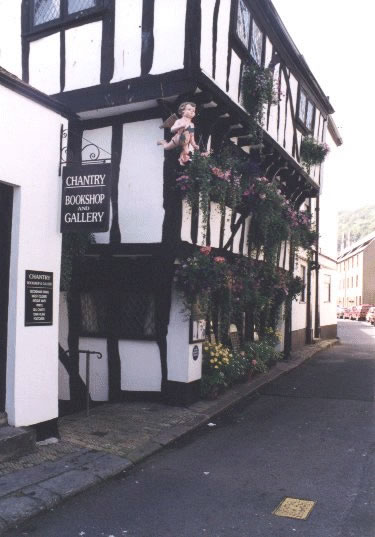 today
a plaque on the quay commemorates this event. Bayards
Cove, with its own castle, has little changed since
the reign of Henry VIII and earlier in 1147 Dartmouth
was the Northern European gathering point for the
2nd Crusade. Dartmouth castle was built on a rocky
promontory overlooking the mouth of the River Dart.
The original fortress was begun in the 14th century
in the very yard of St. Petroc's Church, whose tombstones
reach up to its walls, but most of the building was
carried out during the 15th century. It is the earliest
surviving English coastal castle specifically designed
for artillery. It consists of a square and a round
tower built next to each other to fit the shape of
the rock. Another castle was built on the today
a plaque on the quay commemorates this event. Bayards
Cove, with its own castle, has little changed since
the reign of Henry VIII and earlier in 1147 Dartmouth
was the Northern European gathering point for the
2nd Crusade. Dartmouth castle was built on a rocky
promontory overlooking the mouth of the River Dart.
The original fortress was begun in the 14th century
in the very yard of St. Petroc's Church, whose tombstones
reach up to its walls, but most of the building was
carried out during the 15th century. It is the earliest
surviving English coastal castle specifically designed
for artillery. It consists of a square and a round
tower built next to each other to fit the shape of
the rock. Another castle was built on the 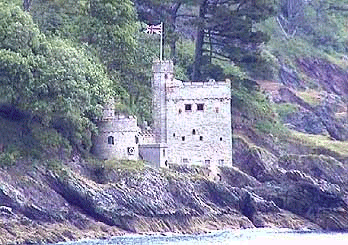 opposite
bank at Kingswear and both fortifications were designed
as protection against French pirates. During the Civil
War Royalists besieged and captured the castle and
held it for three years. When the Parliamentarians
under Sir Thomas Fairfax attacked and took the town,
the Royalists surrendered the castle the next day.
During World War II a brick gun shelter was built
at the castle for use against a possible German invasion.
The Town offers a variety of specialist shops, restaurants
and inns to serve sailors, continuing a tradition
which has survived centuries. Walk into the narrow
streets with the long flights of steep steps, old
quays and the overhanging medieval houses, then you
can easily imagine yourself back in the old days of
wooden sailing ships and press gangs collecting new
recruits from the ale houses. The narrow streets with
their elegant houses and pretty period cottages are
here for those with time to explore, but be warned,
you could fall under the magic spell and be drawn
back to Dartmouth year after year. What sailor, after
a long voyage, could ever forget the picturesque river
with Dartmouth and Kingswear Castles either side welcoming
him home. opposite
bank at Kingswear and both fortifications were designed
as protection against French pirates. During the Civil
War Royalists besieged and captured the castle and
held it for three years. When the Parliamentarians
under Sir Thomas Fairfax attacked and took the town,
the Royalists surrendered the castle the next day.
During World War II a brick gun shelter was built
at the castle for use against a possible German invasion.
The Town offers a variety of specialist shops, restaurants
and inns to serve sailors, continuing a tradition
which has survived centuries. Walk into the narrow
streets with the long flights of steep steps, old
quays and the overhanging medieval houses, then you
can easily imagine yourself back in the old days of
wooden sailing ships and press gangs collecting new
recruits from the ale houses. The narrow streets with
their elegant houses and pretty period cottages are
here for those with time to explore, but be warned,
you could fall under the magic spell and be drawn
back to Dartmouth year after year. What sailor, after
a long voyage, could ever forget the picturesque river
with Dartmouth and Kingswear Castles either side welcoming
him home.
The
River Dart & Dittisham
What ever the weather at sea, you don't have to go
out of the river Dart, as the African Queen can navigate
the three miles up river to the picturesque and charming
village of Dittisham at any state of the tide. The
river provides a fascinating and continually changing
panorama of activity with fishing boats, yachts, moored
craft, ferries, cruise ships, coasters, frigates,
customs cutters and the occasional submarine, you
will pass the famous Britannia Royal Naval College
situated on a hill on the west bank of the river.
Naval officers have been undergoing training in Dartmouth
since 1863, firstly on the wooden two decker man of
war "Hindostan" and then the three decker
"Prince of Wales" renamed Britannia in 1869.
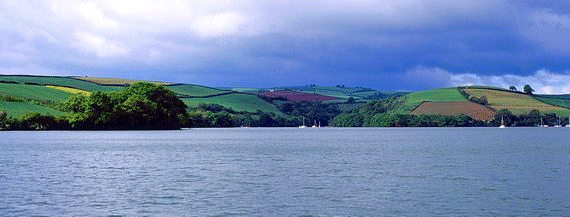 Continuing
up stream the river is navigable for 8 miles to Totnes
at High Water, Picturesque villages, peaceful countryside,
steep sided wooded hills (the name Dart comes from
the Celtic word darthe meaning oak) and there is plenty
of wildlife to see, it is not unusual to see a seal
or two sunbathing on the Anchor Stone Rock just below
Dittisham... Continuing
up stream the river is navigable for 8 miles to Totnes
at High Water, Picturesque villages, peaceful countryside,
steep sided wooded hills (the name Dart comes from
the Celtic word darthe meaning oak) and there is plenty
of wildlife to see, it is not unusual to see a seal
or two sunbathing on the Anchor Stone Rock just below
Dittisham...
Totnes
Totnes is a fascinating old market town and boats
can stay alongside the quay for a couple of hours
near high water. Here you can stroll along the river
walk and island gardens or explore some of the intriguing
back streets of the town.
Day
Cruising from Dartmouth
As you come out between Dartmouth and
Kingswear castles , the glittering expanse of Start
Bay beckons you seawards for the sheer pleasure of
being afloat. The unmistakable profile of Start Point
lies eight miles to the south-west, and between Dartmouth
and Start you have a fine choice of coves, beaches
and anchorages. Red lap Cove is only just around the
corner beyond Combe Point, and then the impressive
sweep of Blackpool Sands opens up just west of Stoke
Fleming village. Beyond Strete Head the long line
of Slapton Sands curves south for nearly three miles
to Torcross. Then, in the most southerly crook of
Start Point, you can anchor off either of the two
small fishing villages known as 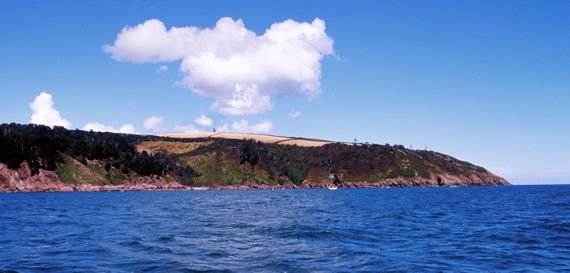 Beesands
and Hallsands. Of course if you fancy a truly lazy
day, you can always anchor for lunch in one of the
secluded coves just outside Dartmouth entrance - Mill
Bay Cove or Newfoundland cove on the east side, or
Combe Bay on the west. The time will pass in quiet
contentment until the sun creeps round over Start
Point and it's time to head back into the river for
an evening drink and a relaxed dinner. Not far north-east
of Dartmouth, round the spectacular craggy island
with its wealth of wildlife, known as the Mew Stone,
we can anchor in clear water off Scabbacombe Sands,
Mansands or St. Mary's Bay. The sheer bluff of Berry
Head lies only five miles north-east of the Dart entrance,
beyond which you enter the beautiful expanse of Torbay,
with Brixham harbour on the south side and Torquay
on the North. Beesands
and Hallsands. Of course if you fancy a truly lazy
day, you can always anchor for lunch in one of the
secluded coves just outside Dartmouth entrance - Mill
Bay Cove or Newfoundland cove on the east side, or
Combe Bay on the west. The time will pass in quiet
contentment until the sun creeps round over Start
Point and it's time to head back into the river for
an evening drink and a relaxed dinner. Not far north-east
of Dartmouth, round the spectacular craggy island
with its wealth of wildlife, known as the Mew Stone,
we can anchor in clear water off Scabbacombe Sands,
Mansands or St. Mary's Bay. The sheer bluff of Berry
Head lies only five miles north-east of the Dart entrance,
beyond which you enter the beautiful expanse of Torbay,
with Brixham harbour on the south side and Torquay
on the North.
Coastal
Cruising Rounding
Start Point into Lanacombe bay, lies Salcombe, about
18 nautical miles from Dartmouth, The next port of
call west, about 20 nautical miles is the River Yealm
and the villages of Newton Ferrers and Noss Mayo,
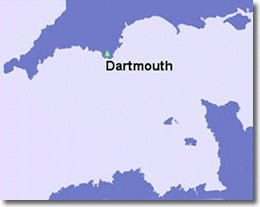 both
well worth a visit . Just round the corner from the
Yealm is Plymouth Sound for those that are looking
for good food, entertainment and on shore facilities.
There are a variety of marinas to choose from, most
surrounded by a good selection of restaurants, bars
and good entertainment. Still going west about 22
nautical miles from Plymouth is the delightful small
port of Fowey, there are many good restaurants here.
Continuing west there are many other interesting places
to visit including Falmouth, Penryn, Mylor and the
Helford River. Going east after Brixham and Torquay
lie Teignmouth and the River Exe then there is quite
a long passage across Lyme Bay and around Portland
Bill to Weymouth, about 50 nautical miles from Dartmouth,
then on to the Solent. both
well worth a visit . Just round the corner from the
Yealm is Plymouth Sound for those that are looking
for good food, entertainment and on shore facilities.
There are a variety of marinas to choose from, most
surrounded by a good selection of restaurants, bars
and good entertainment. Still going west about 22
nautical miles from Plymouth is the delightful small
port of Fowey, there are many good restaurants here.
Continuing west there are many other interesting places
to visit including Falmouth, Penryn, Mylor and the
Helford River. Going east after Brixham and Torquay
lie Teignmouth and the River Exe then there is quite
a long passage across Lyme Bay and around Portland
Bill to Weymouth, about 50 nautical miles from Dartmouth,
then on to the Solent.
Top
|
